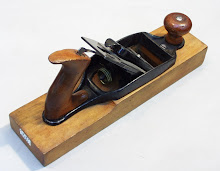The first project was a Panel Jig for my circular saw. It's likely the easiest project going but also one of the most handy. You will need three things:
1 - piece of plywood at least 1/4" thick (I used a 3/4" x 16" x 3-1/2' piece)
1 - piece of wood stock to be used as a guide 1/2" x 1/2" x4' wioul be ideal
6-8 wood/drywall screws that will not poke through both pieces of wood. (My 1/2" + 3/4" > the 1" drywall screws I used.)
The first and most important thing to do is ensure the guide stock is square. I ran it through the table saw on each side to ensure it was smooth and true. Here it is, a nice strip of left over oak.

Next I measured the distance from the outside of the bed of my circular saw to the closest side of the blade. In the photo below you are looking at the bottom of my saw. my thumb is on the side of the bed and my pointer finger is on the saw blade. The distance on mine is 5-1/4".

I set my combination square to 5-1/2" (wider than the measurement of the saw)and marked a line along the factory edge of the board. The square has a groove in one side of the ruler piece. If you place that side down, you can put the tip of the pencil slightly inside and get a pretty accurate line without a straight edge or chalk line. Below is the panel and the square.

Take the guide stock clamp it to the plywood and drill pilot holes for the screws. Remember, you can just drive the screws in the wood, but the material the screw pushes aside has to go some place and usually either splits the board or pushes out the side of the guide which you took the time to make square. Drill the screws into the pilot holes and you are just about in business.
The final step is to clamp the jig to the saw horses or your bench and run the saw along the guide and cut the base to a perfect fit for your saw.
Now there are three things to remember:
First - this jig is made for the saw blade that you cut the jig with. If you have another saw blade you want to use, flip the jig around and cut the other side to size. I cut mine with a plywood/panel blade because that is likely what I'll use it on.
Second - different blades have different thicknesses so be aware of them when laying out your work and cut in the correct side of the line. I have been off by 1/8" more than once because I cut on the wrong side of the line.
Third - be aware of the clearance under the motor of your saw where the guide will be. It may seem great to have a good and sturdy 1" tall piece of oak, but your saw blade will not go as low as it could and you won't be able to cut thicker pieces of stock.
The next project will be to turn my bench saw into a full side table saw with an feed and out feed table. This will likely take several days to complete but will make a $100 saw work like an $800 - $1500 saw. I have begun the layout and worked up a couple of templates and will document my progress tomorrow.
Happy Memorial Day!

No comments:
Post a Comment